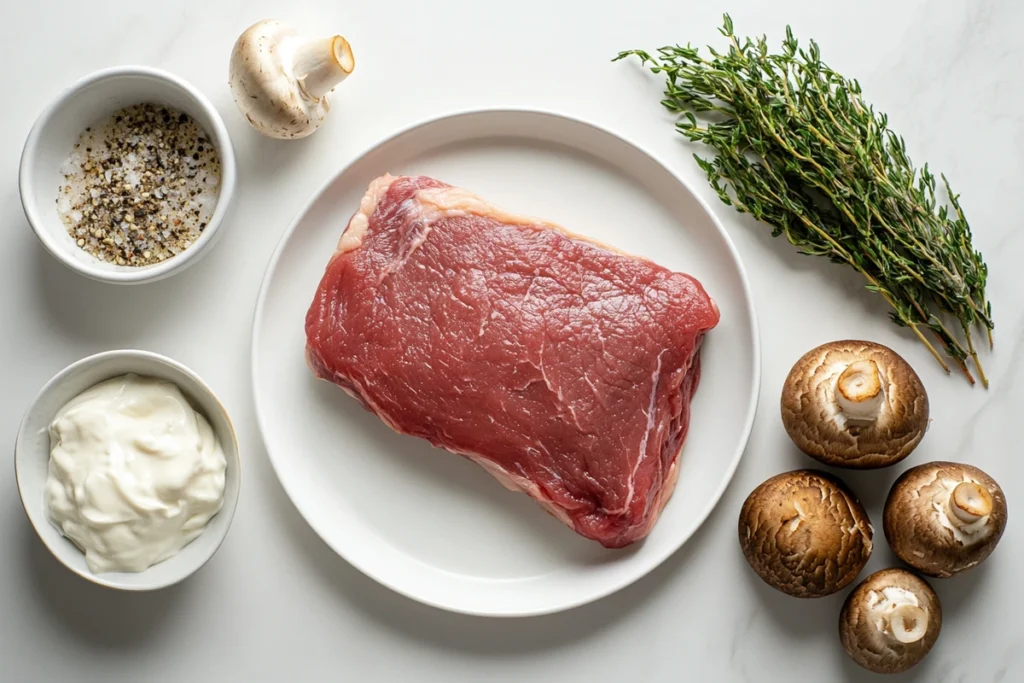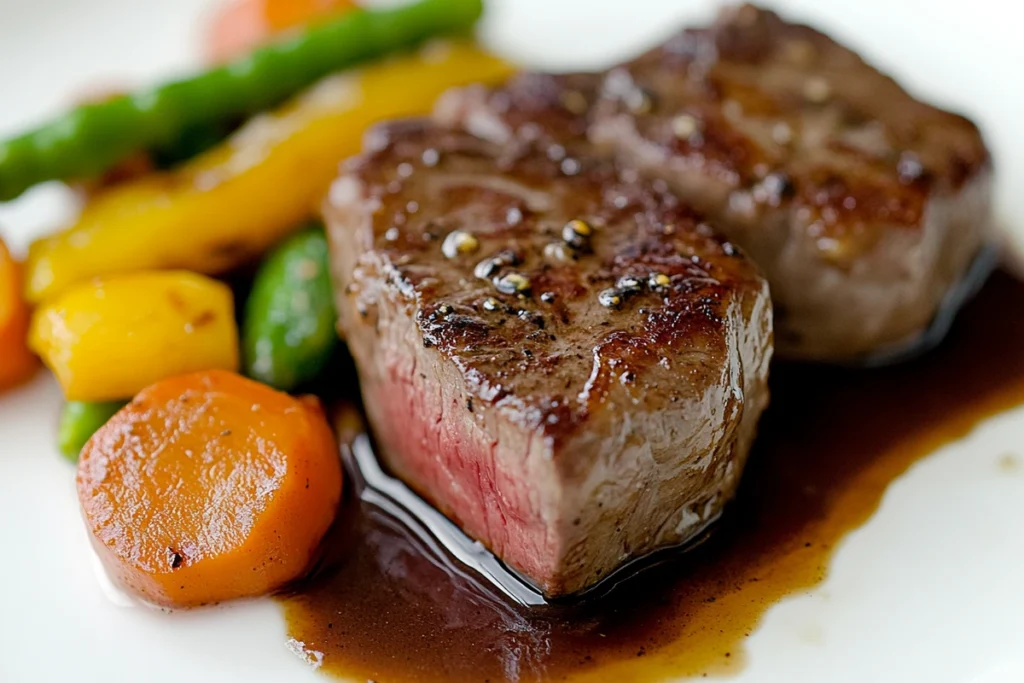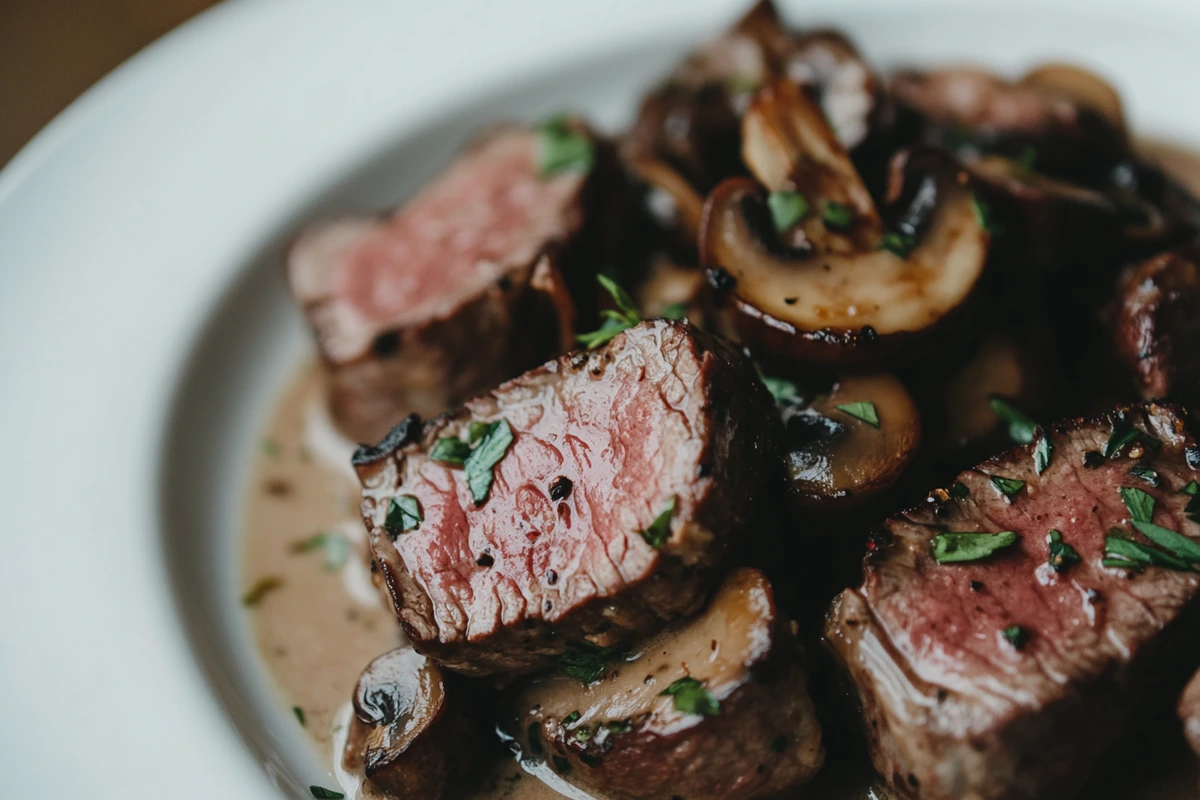Transport your taste buds back to a bygone era with this elegant yet accessible steak diane creation. Learn its background, tips, and modern twists for a flawless meal.
Introduction
Long admired for its theatrical sauce and tender beef, steak diane remains a restaurant favorite. Over time, many cooks have adapted it at home. This article delves deep into each detail: from the sauce’s flambé origins to the best ways to present the finished dish. By the end, you’ll master every nuance, ensuring that your next steak diane dinner is truly memorable and mouthwatering.
Detailed Professional Outline
- Origins and History of Steak Diane
- Early 20th-century influences
- The rise of table-side flambé presentations
- Transition from exclusive restaurants to home kitchens
- Why Choose Steak Diane
- Classic appeal and timeless flavors
- Pairing with various sides and sauces
- Simple steps that produce restaurant-level results
- Key Elements for Steak Diane
- Essential cuts of beef
- Must-have sauce components
- Balancing cream, mushrooms, and cognac
- Core Techniques for Steak Diane
- Achieving a perfect sear
- Building flavor with aromatics and flambé
- Deglazing and sauce finishing
- Serving Suggestions for Steak Diane
- Plating for visual impact
- Side dishes and complementary textures
- Tips for sauce consistency
- Common Pitfalls to Avoid
- Overcooking the steak
- Overpowering the sauce
- Neglecting flambé safety
- Enhancing Your Steak Diane
- Substitutions for liquor or mushrooms
- Creative spins on the sauce
- Integrating modern flavors
- Storage and Reheating
- Cooling methods and safe storage durations
- Proper ways to reheat without losing quality
- Transforming leftovers into new dishes
- Additional Variations of Steak Diane
- Lighter versions with leaner meats
- Veggie-inspired adaptions
- Global spice fusions for updated taste
- Frequently Asked Questions (FAQ)
- What does Diane mean for steak?
- How to make Diane Sauce Gordon Ramsay?
- What is the difference between Steak Diane and steak Oscar?
- What does Steak Diane sauce taste like?
- Conclusion
- Summation of key insights
- Reassurance for home cooks
- Invitation to experiment
I. Origins and History of Steak Diane
Although the full origins of steak diane remain somewhat mysterious, many believe it emerged in mid-20th-century American restaurants. Another possibility is that the concept traces back to European traditions of pan sauce flambé. Over time, this dish earned renown for its theatrical table-side preparation, in which flames danced around the skillet. Whether you credit mid-century chefs in fancy hotels or see older influences, steak diane stands out as an iconic steak presentation.
The dish’s name might link to the Roman goddess Diana, revered as a huntress. Because of this, many guess the original recipe used venison or game meats. Eventually, beef replaced game for convenience, while the flambé sauce served as an elegant showstopper. Meanwhile, celebrity chefs of the 1950s popularized flambéed steak, delighting diners with spectacle and sumptuousness. Another shift occurred when home cooks embraced steak diane, merging the flambé tradition with simpler everyday cooking. Also, grocery stores began stocking the necessary ingredients—like mushrooms, cognac, or cream—making it more accessible.
Furthermore, the dish’s flambé aspect catered to a dinner party vibe. Because the sauce must be prepared swiftly in a hot pan, the process was often done in front of guests. Restaurants realized that patrons relished such displays, and the concept quickly took hold. Over time, certain variations emerged, including different mushrooms or substituting brandy for cognac. Yet the fundamental premise remains consistent: pan-seared steak, a rich sauce featuring cream and mushrooms, and a dramatic flambé. Even modern takes on steak diane tend to honor these roots, maintaining the prized combination of tender beef and luscious sauce.
II. Why Choose Steak Diane
With countless steak recipes available, why focus on a steak diane approach? One reason is that it merges simplicity and style. The core sauce—blend of butter, shallots, mushrooms, cognac, and cream—requires only a few minutes. Yet, the result tastes and looks luxurious. Another argument is that the flambé step, while optional, imparts complexity to the sauce. If you aim to impress dinner guests, few dishes rival the flair of a flambé. Meanwhile, if you skip the fire show, you can still produce a fantastic sauce by gently simmering the spirits.
Steak diane also shines because it suits multiple cuts of beef, from filet mignon to sirloin. Whether you want a lean or marbled piece, the sauce is robust enough to complement any. If you prefer an indulgent approach, a well-marbled ribeye can handle the creaminess. Another plus is the flexible nature of the dish. For instance, you can tweak the sauce’s thickness, adding more stock for a lighter feel or extra cream for a velvety finish. You can also incorporate fresh herbs like tarragon or thyme to personalize the taste.
Additionally, steak diane pairs seamlessly with various sides. Because the sauce is rich, serving it with crisp vegetables, a fresh salad, or even Zucchini Pasta can offset the richness. Another route is to accompany it with classic starches, like mashed potatoes or crusty bread to soak up leftover sauce. If you want a more unique approach, you could consider a bowl of Vegetarian Tortilla Soup as a starter or a tangy side dish. Ultimately, the dish’s adaptability ensures it can fit into diverse menus, from fancy celebrations to cozy nights at home.
Key Elements for Steak Diane

To create a memorable steak diane, you need quality ingredients and the correct techniques. While the dish has many variations, certain elements remain central: the steak, the mushrooms, and the cognac-based sauce.
Steak Diane Meat Selection
- Cut: Many prefer tender cuts like filet mignon or tenderloin. Another option is sirloin if you want a bolder beef flavor.
- Thickness: About one inch thick is common. Because steak diane cooks quickly in a hot pan, thin cuts risk overcooking.
- Seasoning: Salt and pepper suffice. Another approach is a dusting of onion powder or a hint of thyme, but keep it minimal to let the sauce shine.
Additionally, pat the steaks dry before seasoning. Moisture on the surface can impede browning. Another tip is to rest the steak briefly at room temperature so it cooks evenly. Keep in mind you’ll flambé or simmer the sauce in the same skillet, capturing the steak’s browned bits for flavor.
Steak Diane Sauce Foundation
- Mushrooms: Typically button or cremini. Another route is portobello for a more intense taste. Slice them thin for rapid cooking.
- Shallots or Onions: Finely minced for quick sauté. Another approach is skipping these if you want a more straightforward sauce, but they add subtle sweetness.
- Cognac or Brandy: Responsible for the flambé effect and a distinct aroma. If you’re not flambéing, simmer to evaporate excess alcohol. Another alternative is brandy extract, but it won’t match the real complexity.
- Stock: Beef stock or demi-glace intensifies savoriness. Some use chicken stock if beef stock is unavailable, though that can lighten the flavor.
- Cream: Typically heavy cream or double cream. Another method is half-and-half for a slightly lighter sauce, though the sauce might be thinner.
- Seasonings: Salt, pepper, possibly Dijon mustard. Another plus is a splash of Worcestershire sauce for deeper depth.
Combining these sauce elements rapidly is key. After searing the steaks, remove them from the skillet, then sauté mushrooms and shallots in the leftover fat. Deglaze with cognac or brandy, flambé if desired, then add stock and cream. Let it reduce briefly until thickened. Another note: taste continuously, adjusting salt or pepper as needed.
Core Techniques for Steak Diane
Speed and timing matter for a steak diane approach. Typically, the entire dish cooks within minutes. Because the sauce relies on pan drippings, having everything prepped (mise en place) is critical.
Steak Diane Searing and Flambé
- High Heat: Use a cast-iron skillet or heavy pan. Another tip is ensuring it’s large enough to hold the steaks without overcrowding.
- Sear: Cook each side for 2–3 minutes until a brown crust forms. Because overcooking can yield tough steak, track time closely.
- Flambé: If flambéing, reduce the heat, carefully add cognac, then ignite with a long lighter. Another approach is tipping the pan slightly. The alcohol ignites quickly, so keep a lid nearby for safety. Once flames subside, the alcohol’s harshness mellows.
Some home cooks skip flambé, instead allowing the liquor to simmer for a minute or two. This method avoids the open-flame step. Regardless, you want the alcohol to cook off, leaving the sauce’s characteristic tang without raw liquor taste.
Steak Diane Sauce Reduction
- Add Mushrooms: Let them sauté in butter or pan drippings. Another secret is not crowding them, ensuring they brown rather than steam.
- Aromatics: Shallots or onions go next. Sauté until translucent. If using garlic, add it late to avoid bitterness.
- Pour in Liquids: Add stock and cream. Another method is whisking in a small knob of cold butter to finish the sauce, producing a velvety mouthfeel.
- Simmer: Cook until it thickens lightly. Another approach is scraping any browned bits from the pan bottom for maximum flavor.
When the sauce reaches your desired consistency, return the steaks to the skillet briefly, coating them with the sauce. Because the dish is best served immediately, have your sides ready. Plate promptly, spooning extra sauce over the steaks.
Serving Suggestions for Steak Diane
A steak diane meal can be as formal or casual as you choose. The creamy sauce and perfectly cooked meat can anchor a sumptuous dinner. Meanwhile, basic sides can keep it grounded and approachable.
Steak Diane Plating Strategies
- Single Plate Method: Place the steak at the center, drizzle sauce around or over it. Another approach is swirling the sauce onto the plate, then nestling the steak on top.
- Family-Style: Slice the steak into medallions, arrange them on a platter, then pour sauce across. This approach suits larger gatherings, letting guests serve themselves.
Another finishing touch might be sprinkling chopped parsley or chives. Because the sauce is usually light brown, bright garnishes add visual pop. If you prefer a more minimal aesthetic, keep the plate neat, letting the steak’s color speak for itself.
Steak Diane Side Dishes
- Potatoes: Mashed, roasted, or baked. Another alternative is fries for a bistro-inspired vibe.
- Vegetables: Sautéed spinach or asparagus. Alternatively, a crisp salad cuts through the richness.
- Pasta or Noodles: Zucchini Pasta can deliver a refreshing contrast, or standard noodles can soak up sauce.
- Soup: A small serving of Vegetarian Tortilla Soup might seem unexpected, yet it can add tangy flair to balance the richness.
A side of bread or rolls to mop up the sauce is never a bad idea. Because steak diane sauce is so flavorful, you don’t want to waste a drop.

Common Pitfalls to Avoid
Despite being a quick dish, errors can hamper your steak diane experience. By examining potential oversights, you can produce restaurant-quality results.
- Overcooking the Steak: Because the cooking is fast, watch your steak’s doneness carefully. Another approach is using a meat thermometer if you’re uncertain.
- Overpowering the Sauce: The sauce must complement, not overshadow, the steak. Another caution is adding too much Worcestershire or mustard. Start with small amounts, tasting as you go.
- Sauce Separation: If your sauce splits, reduce heat or stir in a bit of cream at the end. Another solution is whisking in cold butter cubes.
- Neglecting Proper Flame Safety: For flambé, ensure the area is clear. Turn off overhead fans to prevent flame spread. Because accidents can happen swiftly, keep a lid or damp cloth handy to smother flames if they get excessive.
Enhancing Your Steak Diane
Though tradition forms the foundation, that doesn’t mean you can’t experiment. Steak diane can incorporate modern twists while retaining its classic essence.
Steak Diane with Alternate Proteins
- Chicken Diane: Swap beef for chicken cutlets. Another approach is pounding them thin for quick cooking. The sauce remains mostly the same, though you might prefer a lighter stock.
- Pork Diane: Pork medallions can handle the sauce’s richness. Because pork can overcook swiftly, keep a close watch.
- Vegetarian Mushrooms: For a meatless spin, use large portobellos as your “steak,” searing them similarly. Another method is pairing them with a sturdy marinade to mimic steak’s heartiness.
Steak Diane with Unique Flavors
- Spicy Kick: Add chili flakes or a dash of hot sauce to the sauce. Another possibility is substituting brandy with a spiced rum for warmth.
- Sweet Accents: Stir in a teaspoon of honey or brown sugar for gentle sweetness. Another method is mixing in caramelized onions for deeper complexity.
- Herbal Variation: Finely chopped tarragon or fresh thyme can highlight the sauce’s creaminess. Meanwhile, rosemary might bring sharper pine notes that some love.
Storage and Reheating
Usually, steak diane is best consumed immediately. However, leftovers can be repurposed if properly stored. Because you might have leftover sauce or partial steak, it’s wise to store them carefully.
Steak Diane Leftovers
- Cooling: Let the steak and sauce cool separately before packing. Another tip is not to leave them at room temperature beyond two hours.
- Containers: Use airtight containers, especially for the sauce, to avoid picking up fridge odors.
- Shelf Life: Generally, steak lasts around 3–4 days in the fridge. The sauce, if cream-based, similarly keeps a few days. Another approach is freezing them for up to 2–3 months.
Steak Diane Reheating Methods
- Stovetop: Warm sauce gently in a small pan. Meanwhile, reheat steak in a low oven or quickly in a skillet with butter. Another approach is combining them right before serving.
- Microwave: Use lower power settings to avoid overcooking. Another possibility is microwaving steak slices separately, then stirring them into warmed sauce.
- Oven: Heat the steak in a foil-covered dish at about 300–325°F until warm. Meanwhile, heat the sauce on the stovetop. Because high heat can toughen leftover steak, remain cautious.
Additional Variations of Steak Diane
A steak diane recipe can adapt to diverse palates, whether you prefer lighter or more indulgent meals. While the original sauce is a combination of butter, cognac, cream, and mushrooms, the possibilities are broad.
Steak Diane with Additional Vegetables
Include sautéed bell peppers or zucchini. Another approach is adding spinach near the end, letting it wilt in the sauce. For a more robust bite, toss in roasted tomatoes or lightly cooked carrots. However, avoid crowding the pan if you want the sauce to remain the star.
Steak Diane with Alternate Liquors
If cognac is unavailable, brandy typically works. Another method is using marsala wine or sherry for a sweeter touch. Meanwhile, whiskey can yield a slightly smokier sauce. Because these spirits differ in sweetness or dryness, taste frequently, adjusting salt or cream.
Steak Diane as a Pasta Dish
Slice the cooked steak into strips, swirl it with the sauce, then toss it with pasta. Another possibility is layering the steak on top of noodles. This approach essentially merges steak diane with a creamy pasta concept. However, ensure you have enough sauce to coat everything thoroughly. If you need more, whisk extra cream or stock into the pan.
Frequently Asked Questions (FAQ)
What does Diane mean for steak?
Historically, “Diane” references a sauce prepared with flambéed liquor, mushrooms, and cream. For steak diane, tender cuts get swiftly cooked, then drenched in this sauce. Some tie the name to the Roman goddess Diana, symbolizing the dish’s gamey origins.
How to make Diane Sauce Gordon Ramsay?
Gordon Ramsay’s method for steak diane sauce typically includes pan-searing the steak with mushrooms and shallots, then deglazing with brandy or cognac. Afterward, he adds stock, mustard, and cream, reducing until thick. Another hallmark is flambé for theatrical flair. Finally, he seasons to taste.
What is the difference between Steak Diane and steak Oscar?
Steak Oscar comprises steak topped with crab meat, asparagus, and hollandaise sauce. Meanwhile, steak diane relies on a mushroom and cognac-based cream sauce. Another distinction is steak Oscar’s link to surf-and-turf tradition, whereas steak diane leans on flambé and a tangy sauce.
What does Steak Diane sauce taste like?
The sauce merges creamy richness, earthy mushrooms, and a mild tang from cognac or brandy. Essentially, a steak diane sauce is buttery, savory, and slightly sweet, with hints of onion or shallot. Some describe it as “umami-laden with a subtle boozy accent.”
Conclusion
Steak diane has endured for decades, proving that classic dishes can remain relevant in modern times. By searing tender beef and crafting a quick, flavorful sauce of mushrooms, cognac, cream, and aromatics, you create a meal that appeals to both old-school enthusiasts and new diners alike. Whether you flambé tableside or simmer the cognac more discreetly, the result is a succulent, sauce-drenched steak that’s sure to impress. Plus, you can incorporate your preferred twists—extra spice, varied mushrooms, or different cuts of beef—without losing that essential steak diane character. Pair it with bright vegetables, a crisp salad, or even a side of Avocado Toast with Feta if you crave a creative fusion. Ultimately, a well-executed steak diane proves that time-honored techniques still elevate the simplest ingredients. Try it soon, and rediscover why this dish remains a hallmark of fine dining at home.

